_____________
Nakanishi Natsuyuki Clothespins Assert Churning Action for a Revolution, 1963
‘Scoop out one of your eyes 5 years from now and do the same with the other eye 5 years later.’
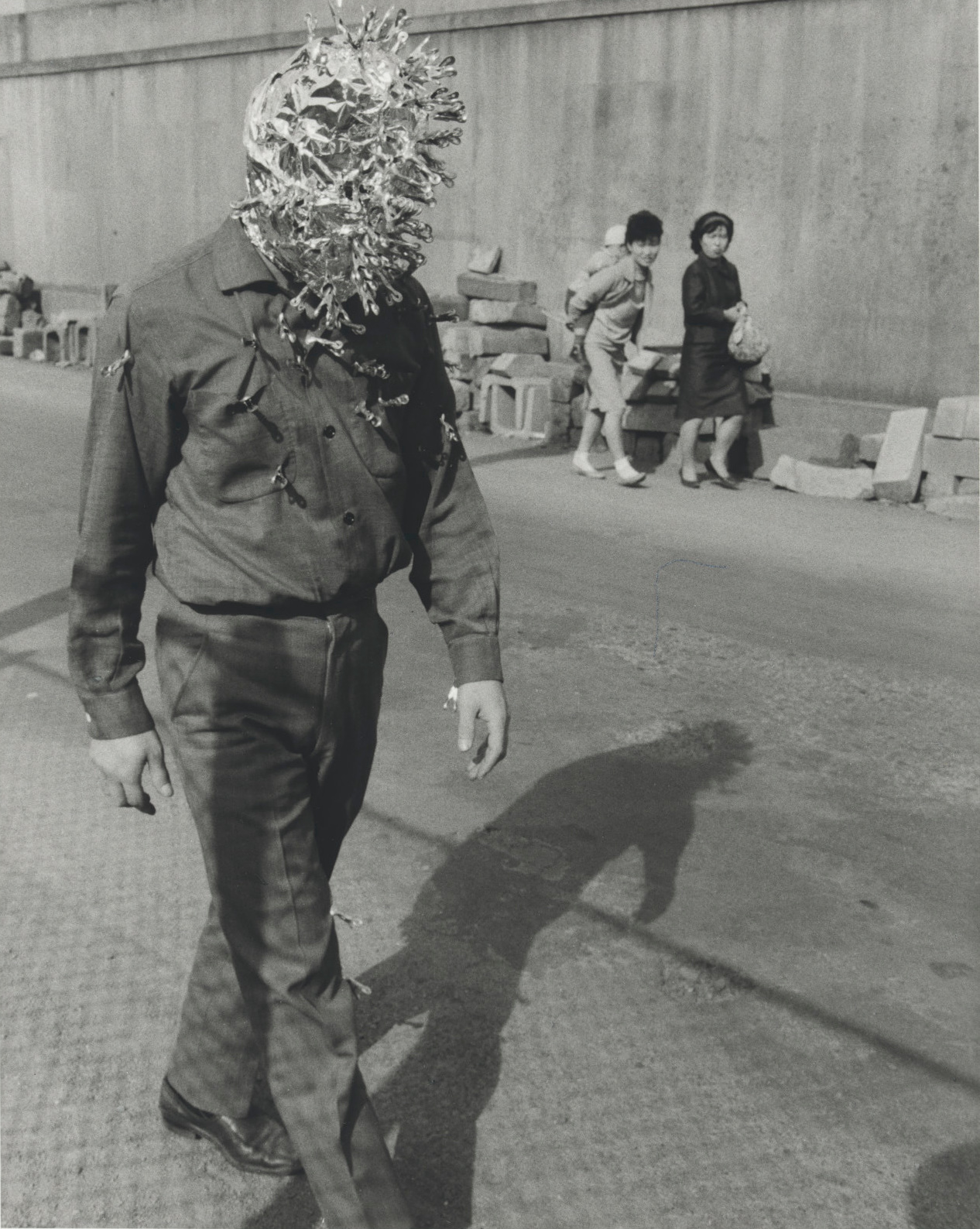
_____________
Mikita Shalenii Where is your brother?, 2013
‘Production photos with the participation of a real squad of special purpose soldiers.’
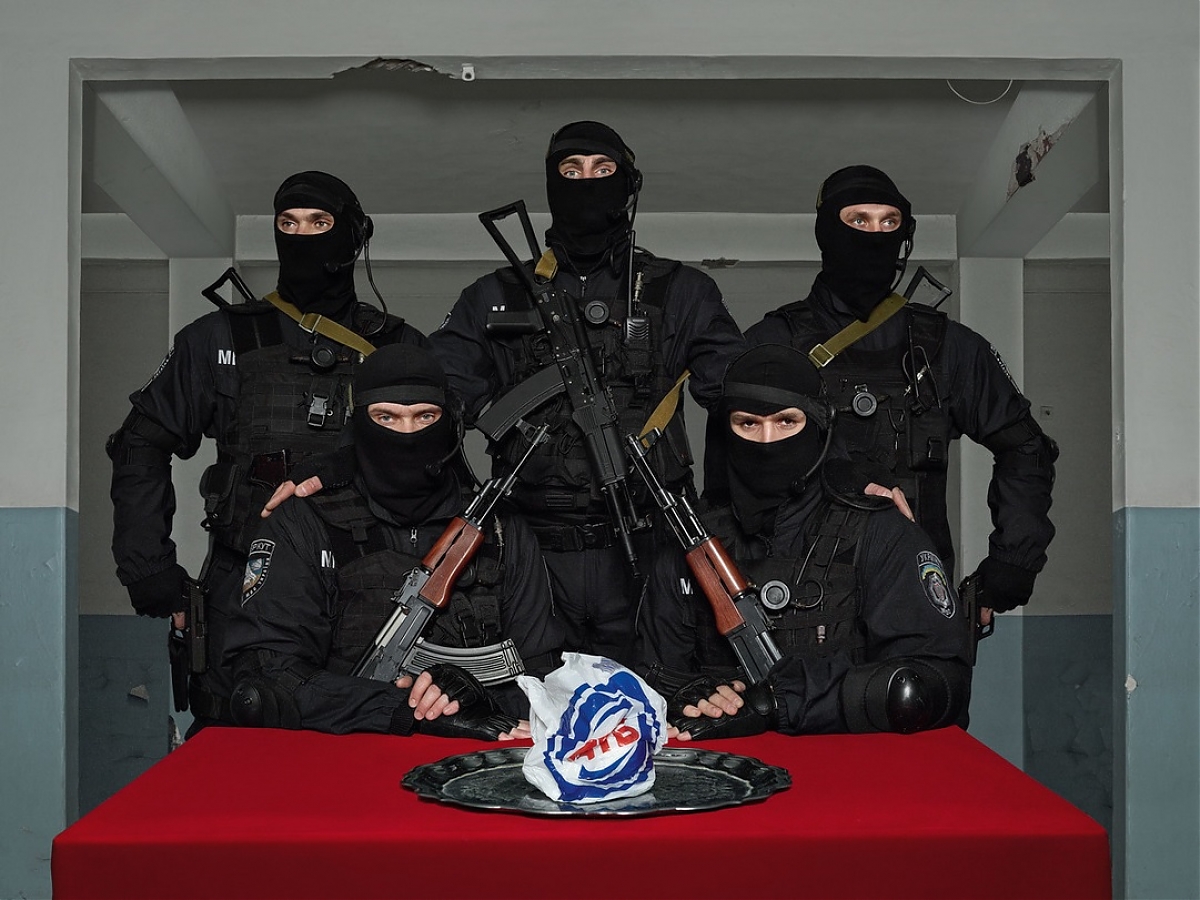

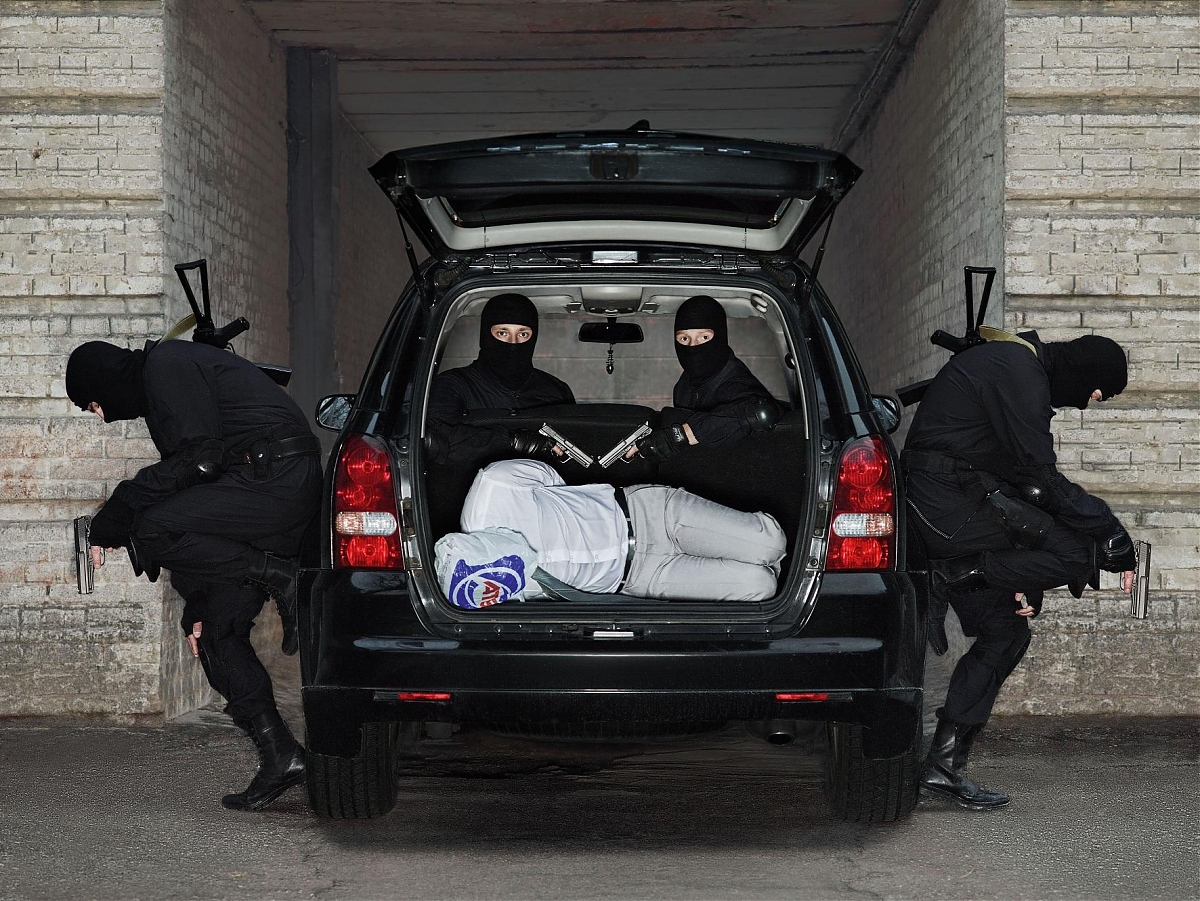
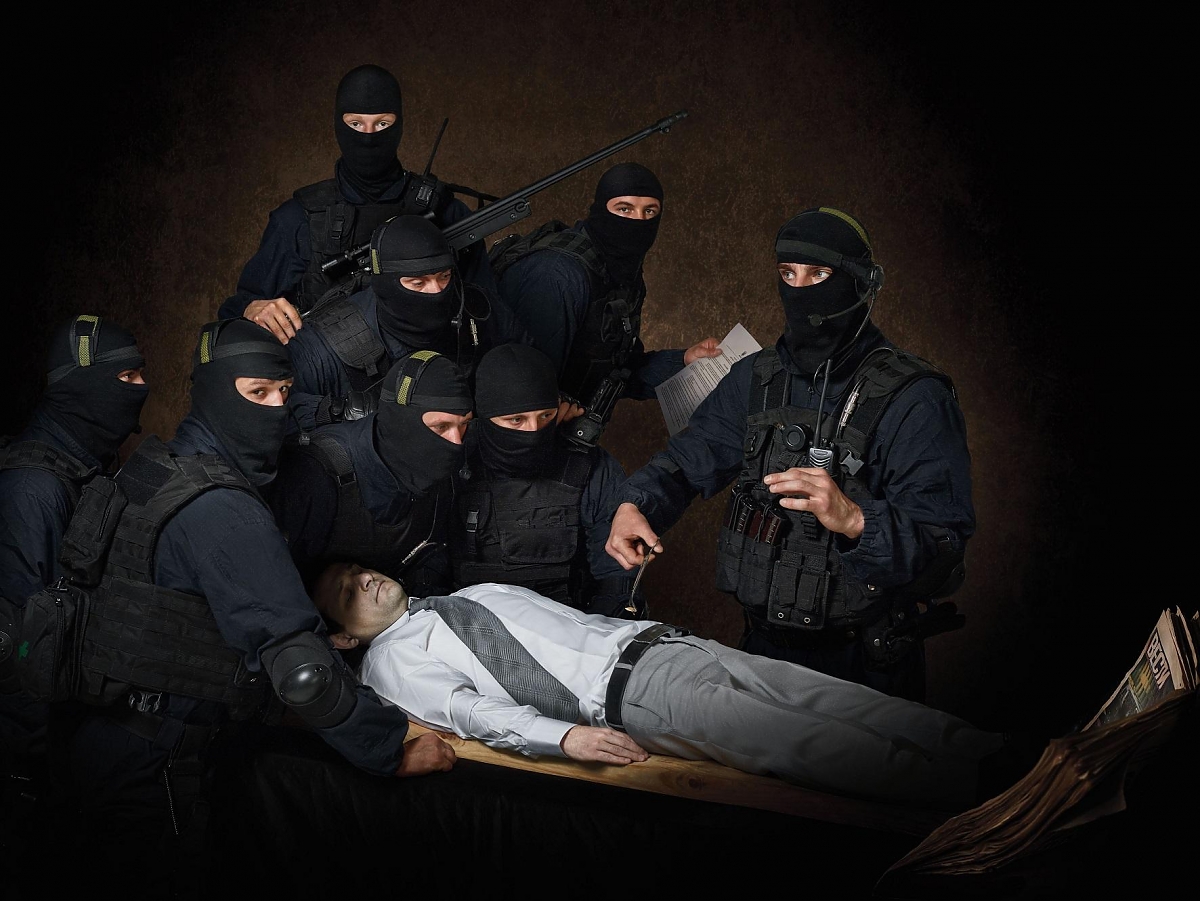
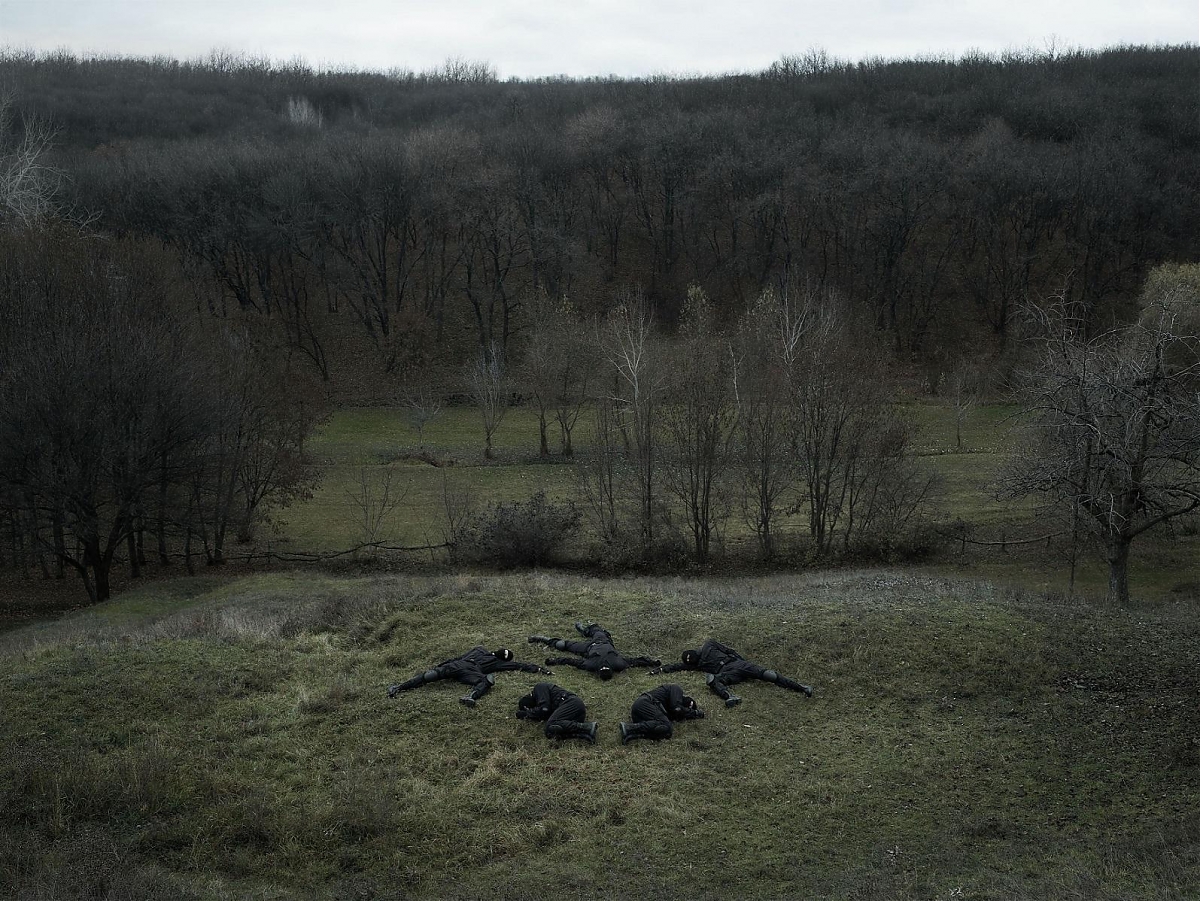
_____________
Huma Bhabha Benaam, 2018
‘Huddled prostrate, is the 18-foot-long Benaam, the Urdu word for “unnamed,” which Bhabha has used in a previous work to memorialize those killed in the Iraq and Afghanistan wars. It is an unsettling figure, almost entirely obscured by what appears to be a large black burqa, or perhaps a garbage bag.’


_____________
Letícia Parente Marca registrada (Trademark), 1975
‘The author sews on the sole of the foot with a needle and a black thread. She embroiders the words “MADE IN BRASIL”. The purpose of the work is to materialize the idea of reification of the individual, a characteristic aspect of society at the present time in history. Reification implies belonging. Belonging, however, transcends the reification due to the deep, impenetrable connection to the motherland. The trademark may resemble the branding iron for indicating the animal ownership, but it is also the basis for the structure over which an individual will always be constituted in her historicity: when standing on the sole of the foot.’
_____________
Emory Douglas Various, 1967 – 1974
‘Known both as a political activist and an artist, Emory Douglas was the Minister of Culture for the Black Panther Party from 1967 to the 1980’s, when the Party disbanded. As the art director and the main illustrator for “The Black Panther”, the weekly newspaper of the organization, he broadcasted his graphic art from Oakland to a national and international audience of readers. His bold lines, reminiscent of woodblock printing, and the way he portrayed the oppressed not as victims but as rebels ready to take up arms, made his style unique. The circulation of his drawings on a large scale through the press allowed him to imprint on the collective imagination, making his art both popular and iconic.’

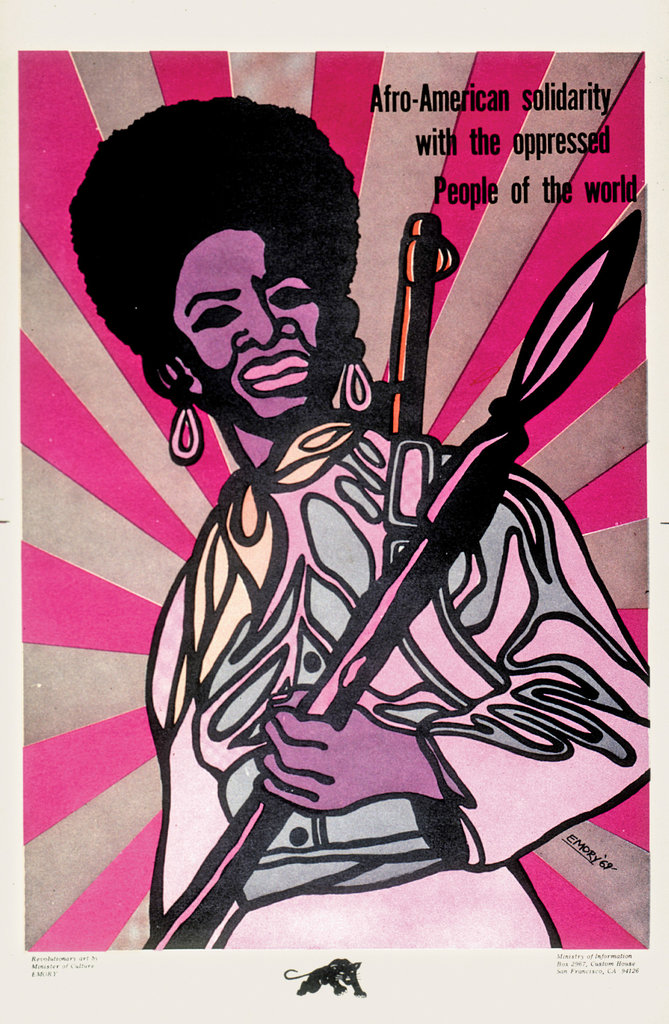
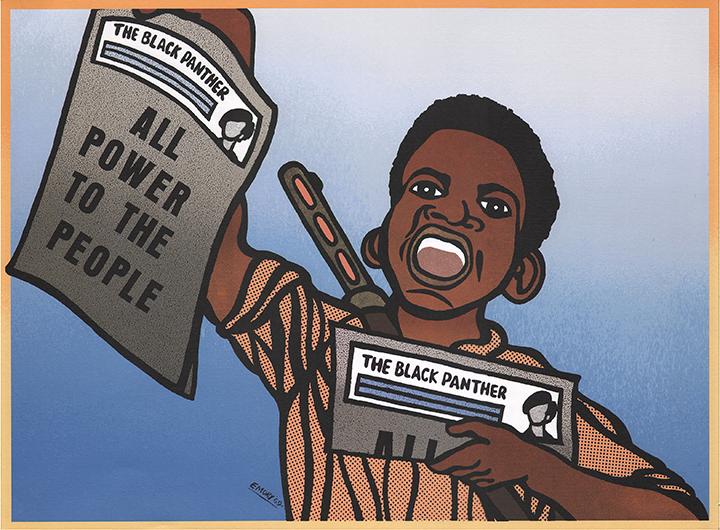


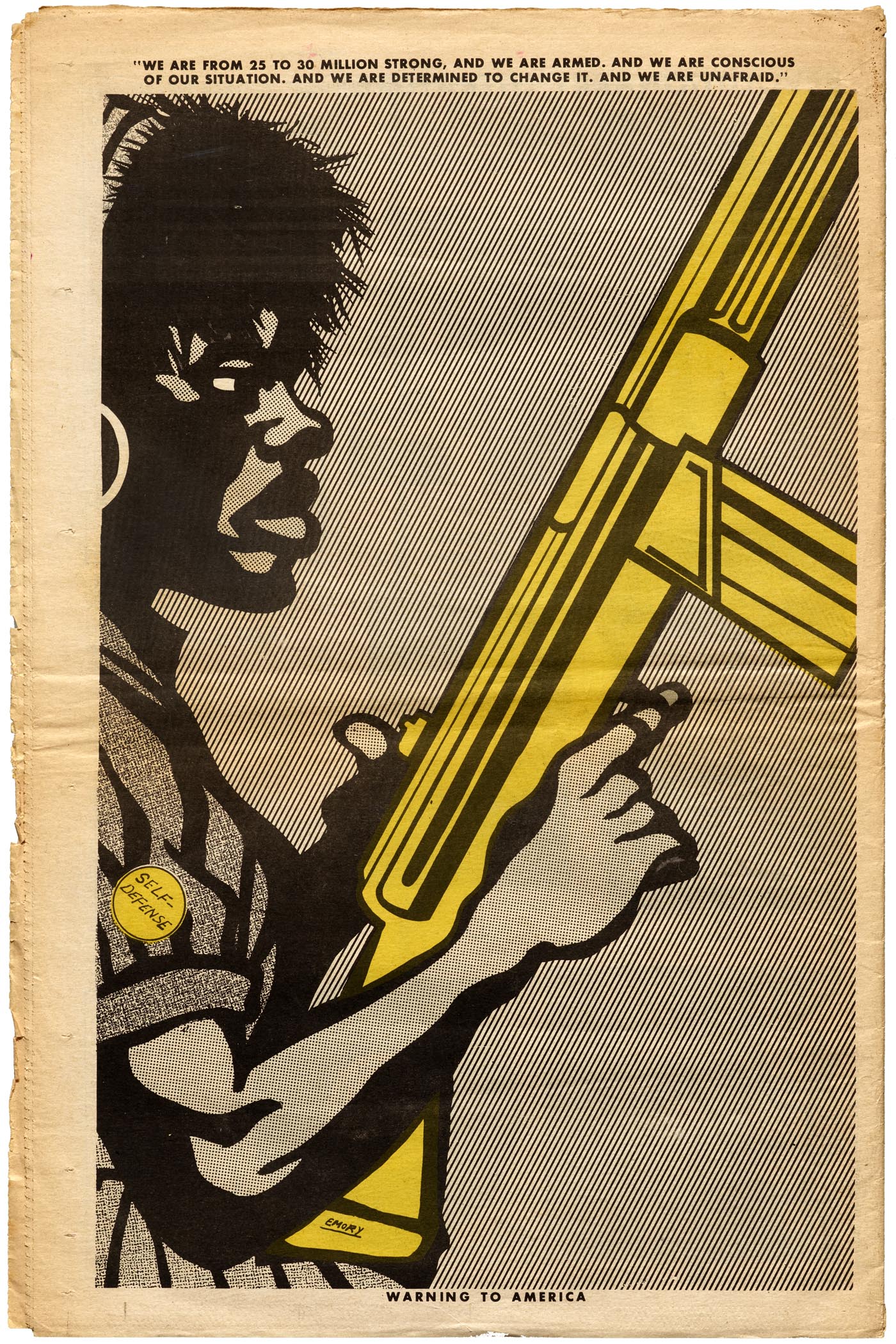
_____________
Bai Yiluo Civilization, 2007
‘Bai’s Civilization is a monument enshrining imperious power as a corrupted vision built on labourers’ toil. Made from terracotta, classical busts pose as emperors and slaves, pierced through and defined by agricultural tools, a life force and bane. Set upon twelve individual plinths, Civilization bridges reference to both Eastern and Western spiritualism, while its violent form suggests revolution, conflict, and rebirth as the isochronal quality of nature.’

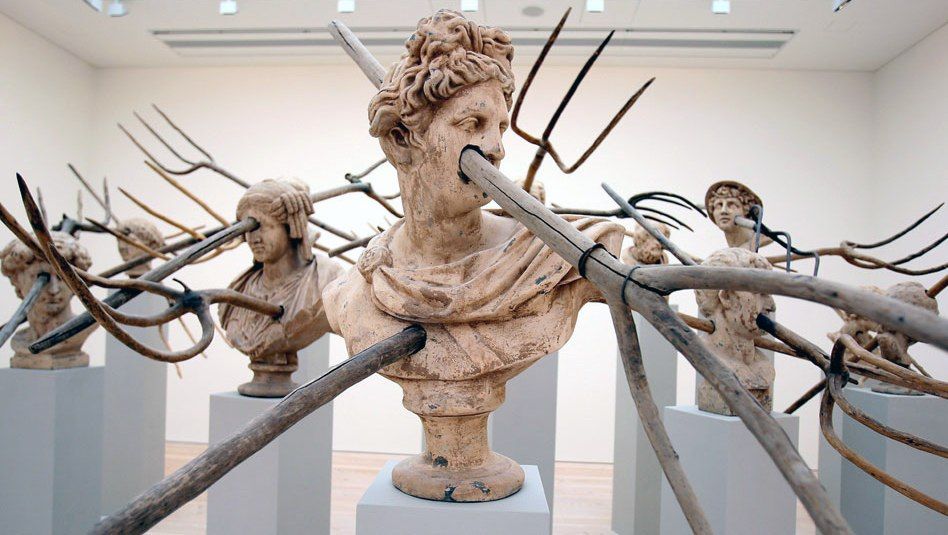
_____________
Chto Delat The Builders, 2004-05
‘In The Builders, an early work by radical Russian art collective Chto Delat, five artists restage a painting in which rugged, socialist realist workers (four men and one woman) take a break from their labour (characteristically, the act of work itself couldn’t be represented in the idealised poetics of socialist realism) to pose hieratically against the distant backdrop of an industrial town. That town is Bratsk, in Siberia, and the painting is a Soviet classic, Viktor Popov’s Builders of Bratsk (1961). The Builders is typical of the preoccupations of Chto Delat, who often dust off the ancient traditions of the USSR in order to test their meaning in the here and now. Fifty years on from the original painting, the simple act of repetition reveals the new meaning of labour and community in the new post-communist reality. The new society is shown to be passive, incapable of change, hanging in the void — a commentary on the disappointment that followed the bold promises of the arrival of the democratic order in the early Nineties.’
_____________
Cady Noland Oozewald, 1989
‘On November 24th, 1963, America watched Jack Ruby shoot the assassin Lee Harvey Oswald at point-blank range as the Dallas police prepared to transfer him by armored car from their headquarters to a nearby county jail. This was the beginning of a tumultuous decade whose commencement can be pinned to the assassination of President John F. Kennedy just two days earlier. What was happening in America? Such uncertainty and such violence elicited tremendous fear of what would take place next. Conspiracy theories proliferated as the American Camelot fell and the American ideal came crashing down with it. Noland’s silkscreened image of Oswald on a thick aluminum plate with 8 perforations symbolizing larger-than-life bullet holes is a harsh depiction of that day’s violence and a greater symbol of the changes America would face during the coming decade. The bullet hole where one expects Oswald’s mouth is stuffed with a balled-up American flag, a symbol of pride, patriotism and memorial callously gagging the already dying man. In Noland’s conception, this is what America has been reduced to – a nation frenzied by intimidation and fear: here and in many of her works Noland conveys that the American dream does indeed have its limitations and shortcomings.’

_____________
Leon Golub Various, 1980 – 1984
‘Though Golub’s paintings were often controversial, that was precisely the point. “He wanted to get a rise out of people,” said Baum. “He used the word ‘contact’ a lot and he painted his characters to look back at you.” But where would his paintings be without politics? They certainly wouldn’t have the same fire and fury. “Golub once said after the Vietnam war he had an artistic crisis,” said Baum, “because so much of his work was tied to the war and he wasn’t sure the direction his art should take after.” In the 1980s, Golub looked to hidden government operations, terrorism and urban street violence for inspiration. Some paintings showed nudes being questioned by the police; others showed torture chambers and one man hanging from his feet being kicked by a soldier.’
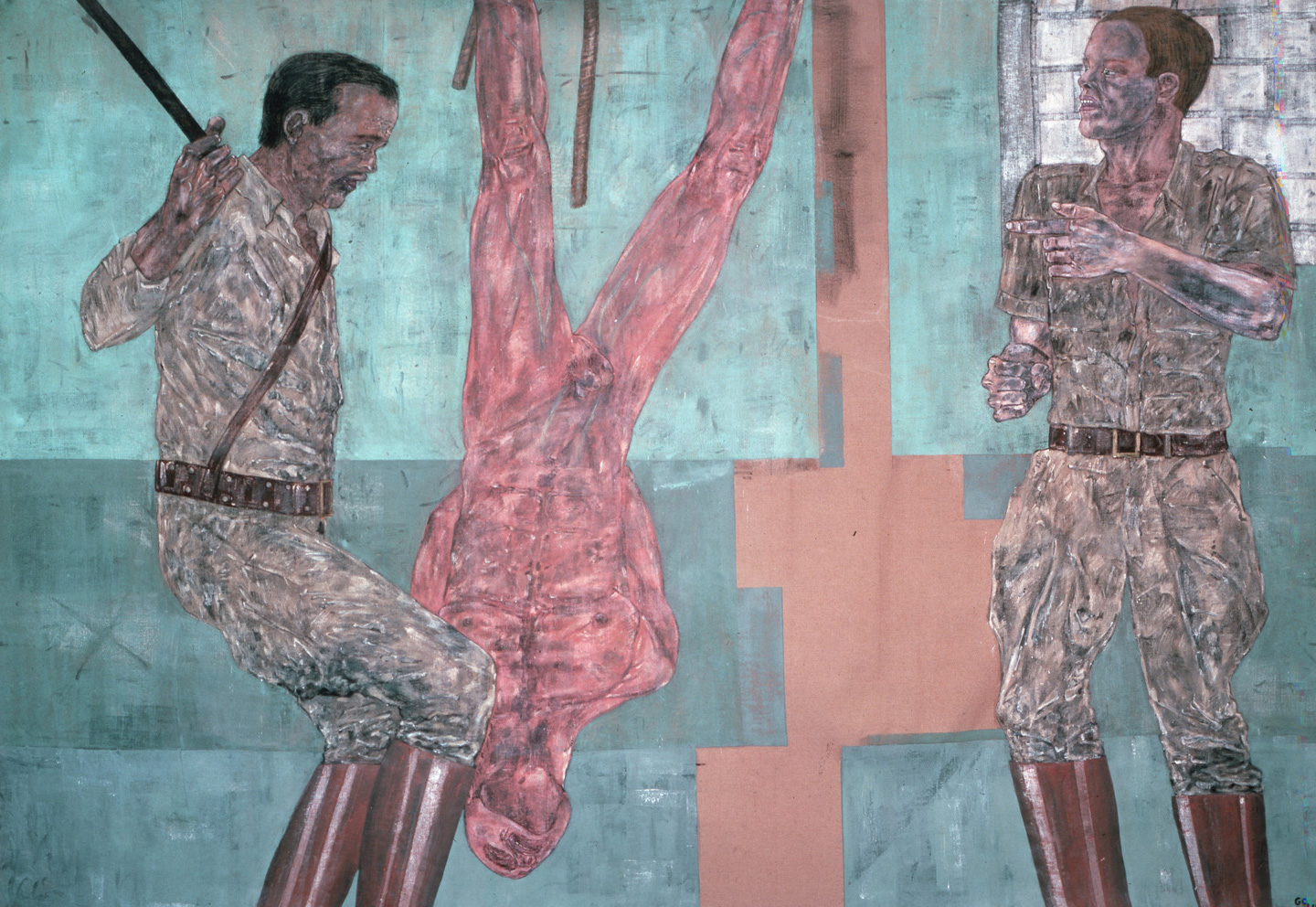

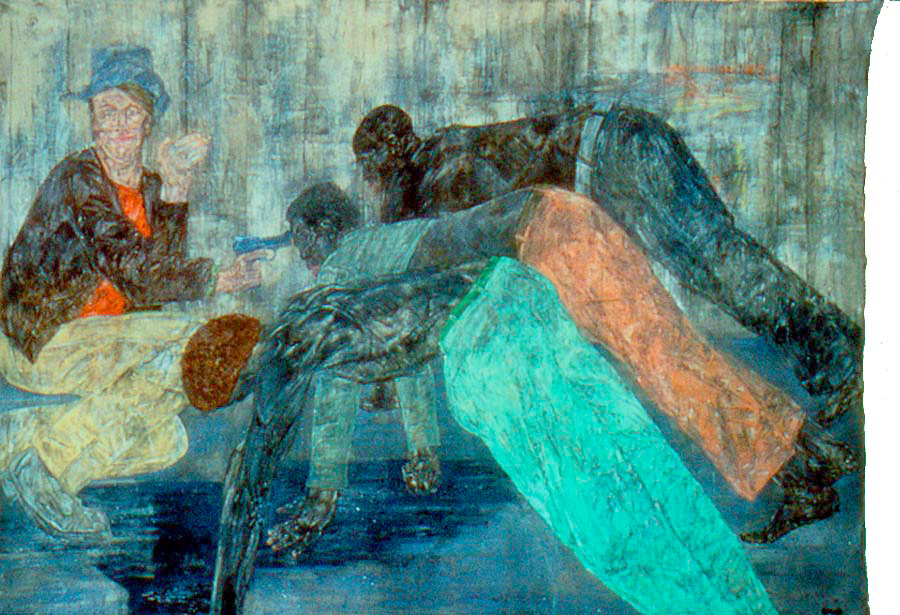
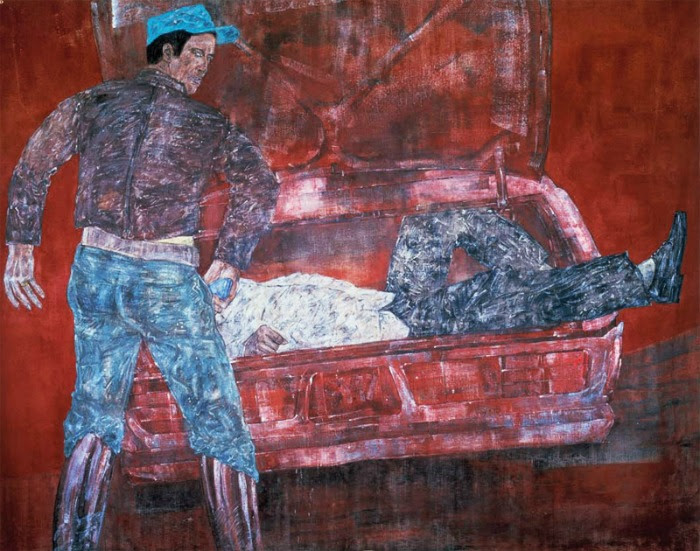
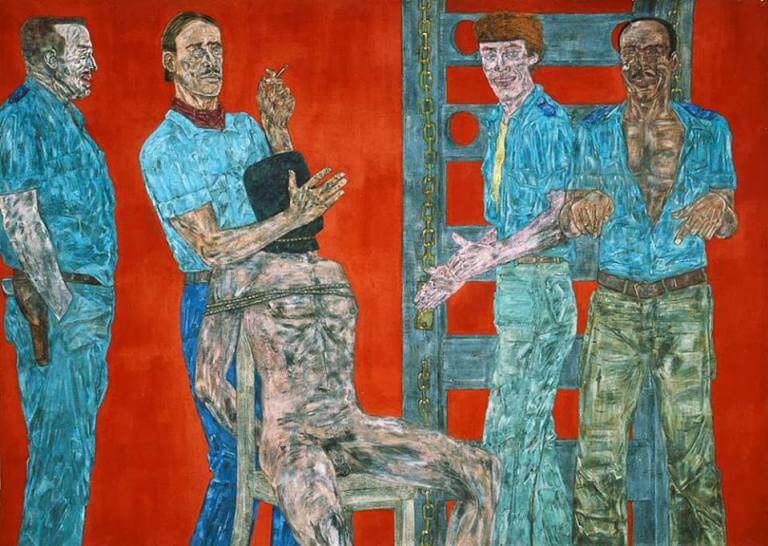
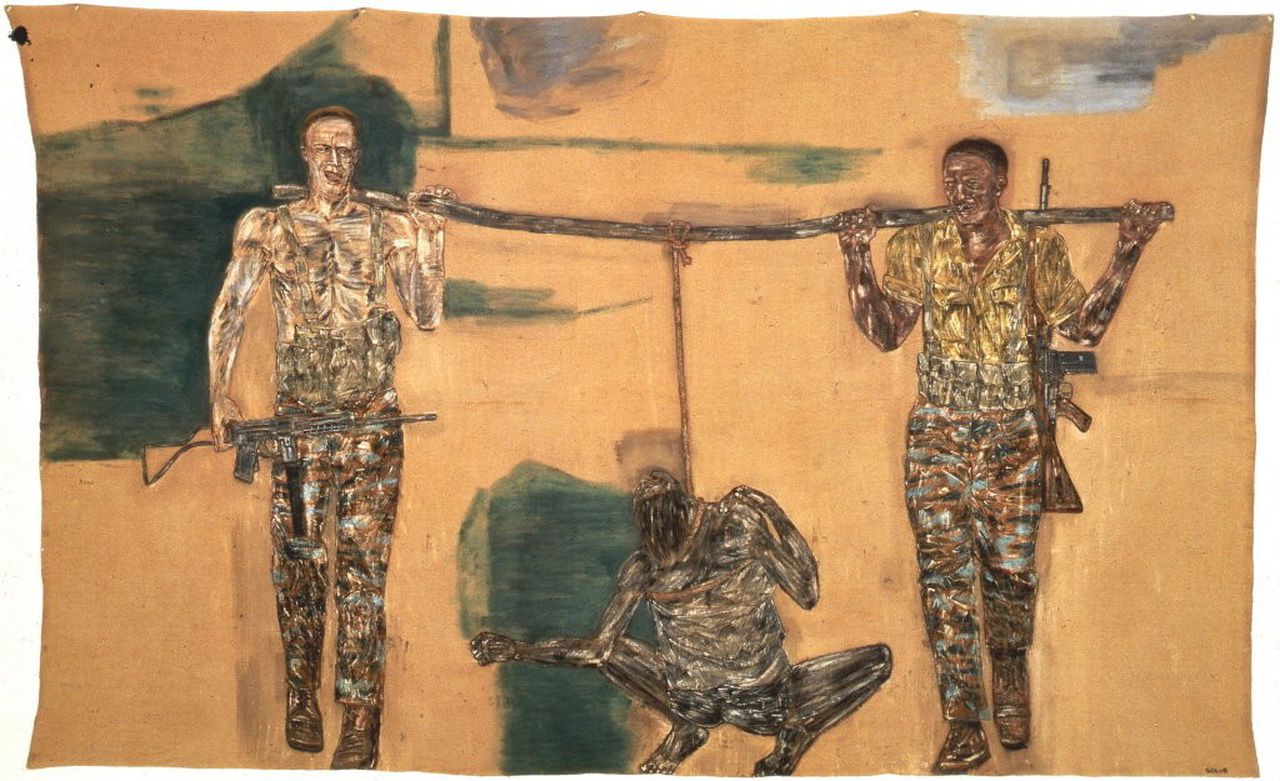
_____________
Ghasem Hadjizadeh Wedding, 1980
‘The 1979 Iranian revolution, which overthrew Mohammad Reza Shah Pahlavi, was a rupture point not just for the art history of Iran but for the society at large. Under the secularising regime of the last shah, from 1941 to 1979, a loose group of artists called the Saqqakhaneh fused avant-garde theory with Iranian folk culture motifs, producing a strain of 1960s modernism rooted in popular culture. This “spiritual pop art” movement combined lustrous Persian dynastic emblems with numerology and calligraphic forms.
‘Iranian modernism was supported by the royal ruler through state-sponsored festivals. Empress Farah Pahlavi, in particular, fostered a flowering of the arts, say pro-monarchists. The collection of the Museum of Contemporary Art in Tehran, which includes work by Pablo Picasso, Mark Rothko and Francis Bacon, was formed under the auspices of the empress. Cultural exchange with the west also stepped up a gear. The royal couple were trying to move the country forward into the new century and that automatically always comes at a cost.
‘The shah was, indeed, a very public patron of the arts but did he use soft culture-based diplomacy to mask the harsher aspects of his rule? The egalitarian desires of Saqqakhaneh and other artists can appear to be almost inseparable from monarchist attempts to cover over the real conditions of social and economic inequality with images of a unified nation. When contemporary Iranian artists address what constitutes national identity, the bedrock of Iranian modernism, they are also questioning official state narratives.
‘But does this make all post-1979 art inherently political, especially during the two-term tenure of Mahmoud Ahmadi-Nejad from 2005 to 2013? What is certain is that post-revolution artists have become spokespeople for the country’s state of mind. Pre-1979, there was more art for art’s sake but since then many artists have become activists, fighters, though they may have not necessarily wanted to.’

_____________
Xu Weixin Huang Shuai 黄帅 & Meng Fei蒙飞, 2005
‘One of the most striking features of Weixin’s monumental portraits is his choice of subject. Weixin broke the artistic monopoly of the great leader being the sole subject of portraiture. He showed that ordinary people, even in their ordinariness, could have a kind of grandeur that was as worthy of remembrance as the high and the powerful. This was unprecedented. Particularly in his cultural revolution series, he painted ordinary civilians. This represents a dramatic departure from Chinese realistic paintings of the past, which focused on important leaders and promoted the moral and political purposes of the government. Unlike traditional views, Weixin believes that “Whether great leaders or ordinary folk in society, they are all representatives of the times, and they are all equally important.”’
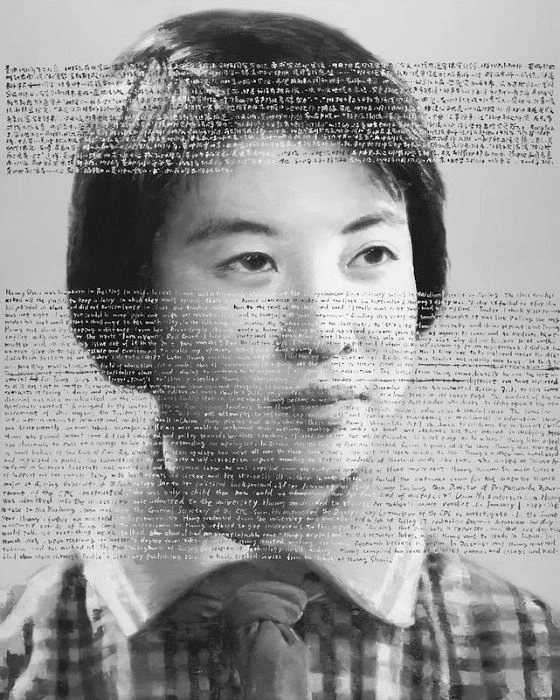

_____________
Suzanne Lacy Lamb Construction, 1973
‘Lacy began by reconstructing a lamb carcass, nailing internal organs onto a saw horse and adding a head and tail, as nearby a man, dressed as a woman, made links of sausage from ground meat and hung the sausage from a meat hook on the wall. A long white runner became a tablecloth and dishes were set for the audience. Overhead, beef kidneys swung on long strings from the ceiling. On the kidneys, white and black mice ran up and down the string and explored the kidneys. Two young girls dressed in white brought pieces of birthday cake for the audience.’
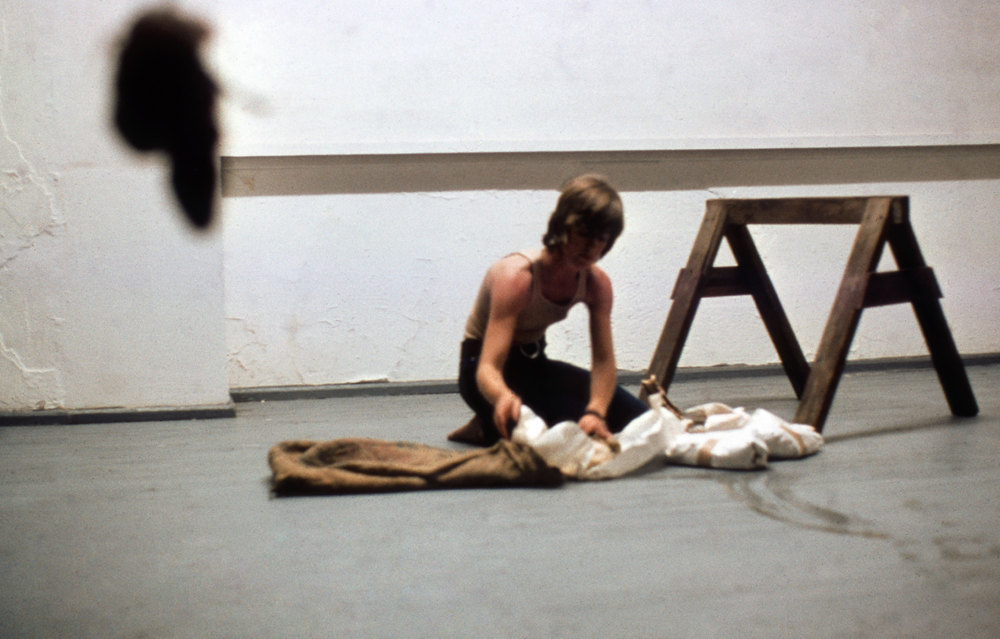



_____________
Shaweesh The Last Jedi Master, 2013
‘At first glance, the image simply appears to be an old photograph documenting the late King Faisal’s participation in a meeting at the United Nations. It only takes a moment longer, however, to notice the small figure just over his shoulder, none other than Yoda, a character from the Star Wars franchise, appearing to act as advisor to the King. It’s a work that carefully toes the line of acceptability, as insulting the royal family would be a crime, but the image isn’t necessarily insulting. It’s a tongue-in-cheek mixing of popular culture and tradition, and can be argued and interpreted in many different ways, helping it avoid cases of overt censorship while allowing it to play with political themes.’

_____________
David Hammons How Ya Like Me Now?, 1988
‘Artist David Hammons, never one to shy away from dicey issues, addressed American electoral quandaries with his 1988 artwork How Ya Like Me Now? Created for the nonprofit organization Washington Project for the Arts (WPA), the 14-by-14-foot painting (first installed at a downtown parking lot in Washington, D.C.) portrayed Jesse Jackson—an African-American preacher and two-time presidential candidate—as a Caucasian man with white skin, blonde hair, and blue eyes. Across the bottom, Hammons spray-painted the artwork’s provocative title. The depiction created furor in the nation’s capital: A group of about 10 locals smashed it with sledgehammers before WPA staff could finish mounting the work. Hammons integrated the attendant anger into subsequent iterations of his piece.’
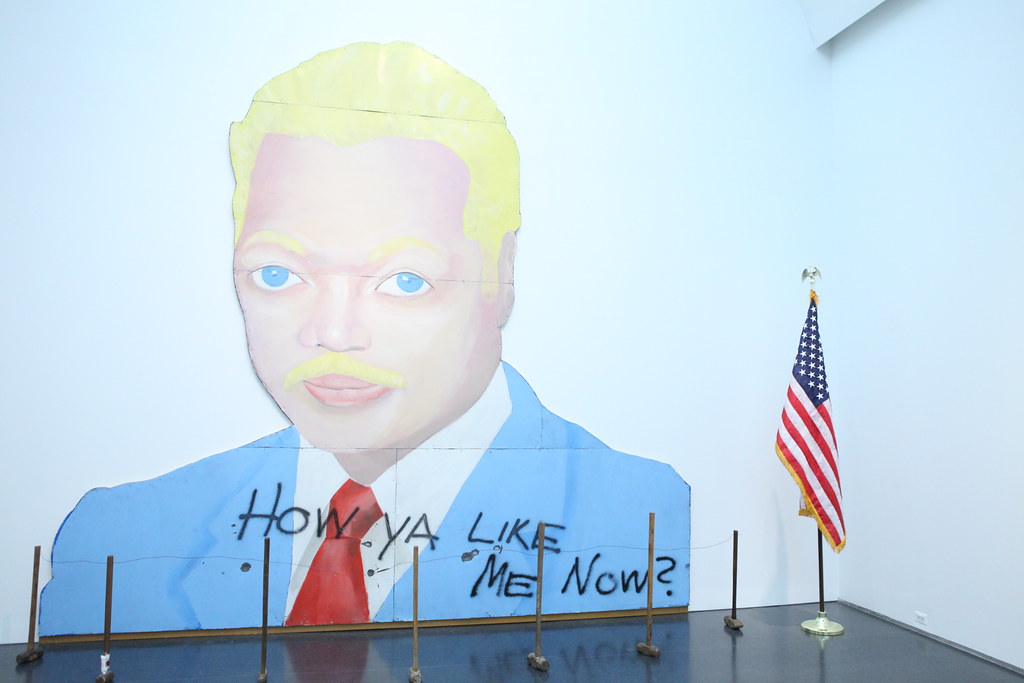
_____________
Zhang Dali Chinese Offspring, 2003
‘According to the artist, immigrant workers who have traveled from the rural areas all over China to earn a living in construction sites in Chinese cities, are the most important members of the Chinese race, who are shaping our physical reality. Yet, they are the faceless crowd who live at the bottom of our society. To cast them in resin is a way to recognize their existence and contribution as well as to capture a fast-changing point of time in the Chinese society. From 2003 to 2005, Zhang has portrayed 100 immigrant workers in life-size resin sculptures of various postures, with a designated number, the artist’s signature and the work’s title “Chinese Offspring” tattooed onto each of their bodies. They are often hung upside down, indicating the uncertainty of their life and their powerlessness in changing their own fates.’



________________
Up Against the Wall Motherfucker Garbage, 1968
‘Up Against the Wall Motherfucker, often shortened as The Motherfuckers or UAW/MF, was a Dadaist and Situationist anarchist affinity group based in New York City. This “street gang with analysis” was famous for its Lower East Side direct action. The Motherfuckers grew out of a Dada-influenced art group called Black Mask with some additional people involved with the anti-Vietnam War Angry Arts week, held in January 1967.[ Formed in 1966 by Ben Morea, a painter of Catalan origins, and the poet Dan Georgakas, Black Mask produced a broadside of the same name and declared that revolutionary art should be “an integral part of life, as in primitive society, and not an appendage to wealth”. In May 1968, Black Mask changed its name and went underground. Their new name, Up Against the Wall Motherfuckers, came from a poem by Amiri Baraka. Abbie Hoffman characterized them as “the middle-class nightmare… an anti-media media phenomenon simply because their name could not be printed”.
1967 – Forced their way into The Pentagon during an anti-war protest.
1967 – Flung blood, eggs and stones at U.S. Secretary of State Dean Rusk who was attending a Foreign Policy Association event in New York.
January, 1968 – “Assassinated” poet Kenneth Koch (using blanks).
February, 1968 – Dumped uncollected refuse from the Lower East Side into the fountain at Lincoln Center on the opening night of a gala “bourgeois cultural event” during a NYC garbage strike (an event documented in the Newsreel film Garbage).
1968 – Organized and produced free concert nights in the Fillmore East after successfully demanding that owner Bill Graham give the community the venue for a series of weekly free concerts. These “Free Nights” were short-lived as the combined forces of NY City Hall, the police, and Graham terminated the arrangement.
December 12, 1968 – Created a ruckus at the Boston Tea Party after the MC5 opened for the Velvet Underground one of the Motherfuckers got on stage and started haranguing the audience, directing them to “…burn this place down and take to the streets…”. This got “The Five” banned from the venue.
December 18, 1968 – Rioted at an MC5 show at the Fillmore East. Some “beat (Graham) with a chain and broke his nose”. This got the Detroit band banned from all venues controlled by Graham and his friends.
August 1969 – Cut the fences at Woodstock, allowing thousands to enter for free.

________________
Helmut Smits Photo Tip, 2004
‘An installation which allows people to be portrayed as a hostage flanked by threatening terrorists.’

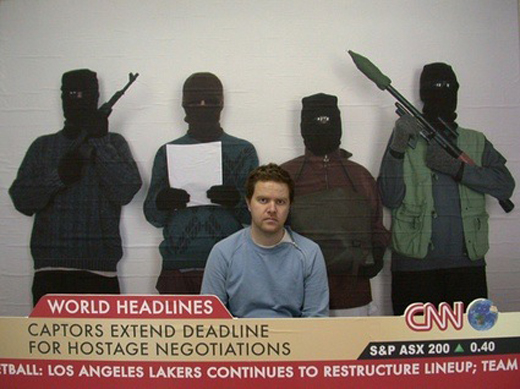
________________
Jinah Roh Mater Ex Machina, 2019
‘Mater Ex Machina is a robot that learns human expressions through machine learning to embody the relationship between man and technology. Jinah Roh, an interactive media artist, used traditional sculpting techniques to create the face of the robot modelled on her own mother. The humanoid learns the audience’s facial expressions, accumulates data, and imitates these gestures to visitors. These behaviors of the bot convey an emotional warmth and empathy, expanding the potential relationship with humans.’

________________
Shi Xinning Various, 2001 – 2007
‘Shi Xinning’s paintings, influenced by social realism and European styles, draw on iconic photographs of figures such as Mao Zedong to reflect on the uncanny reality of the twentieth century.’
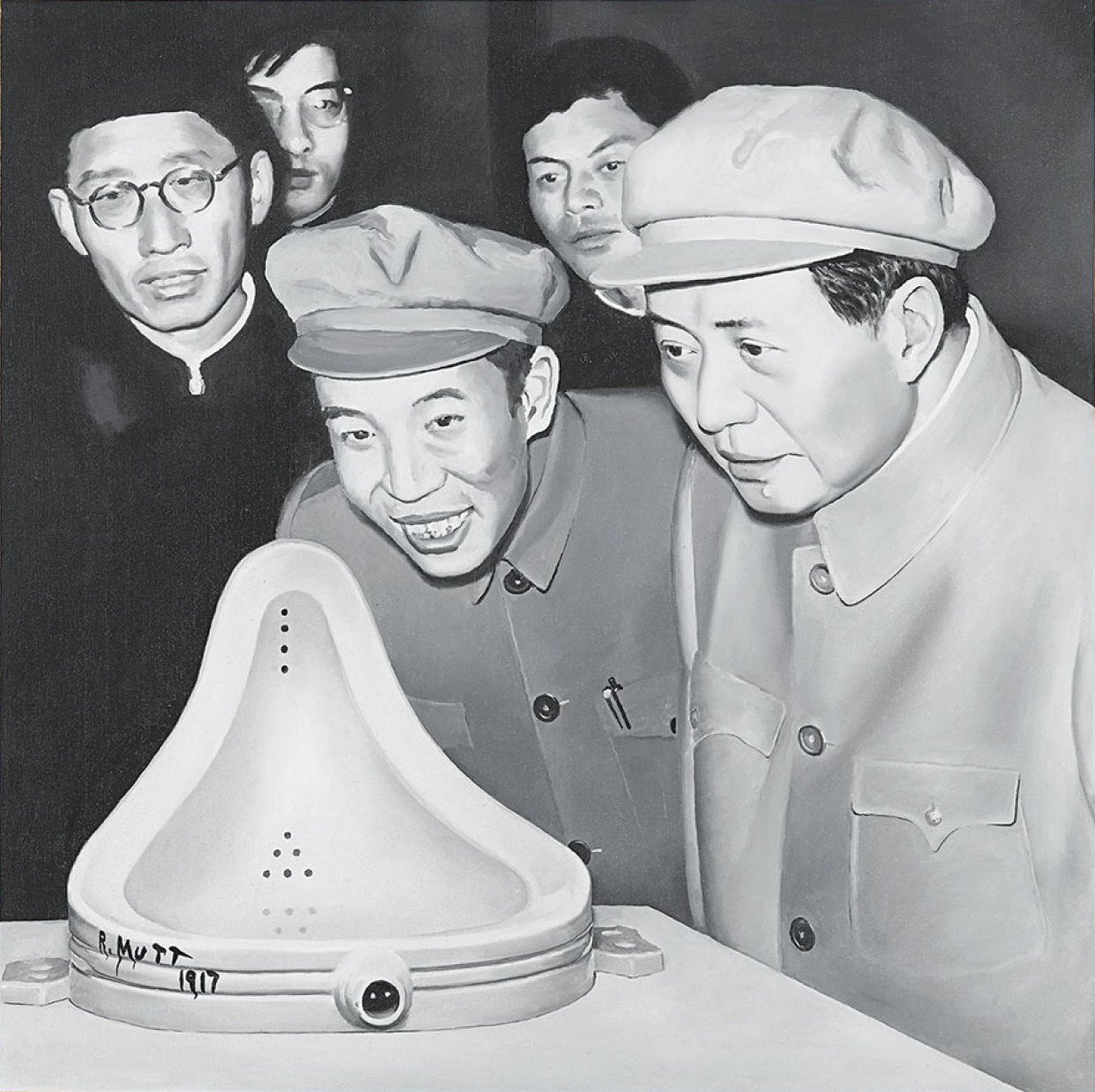

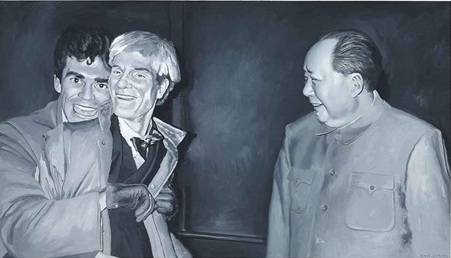
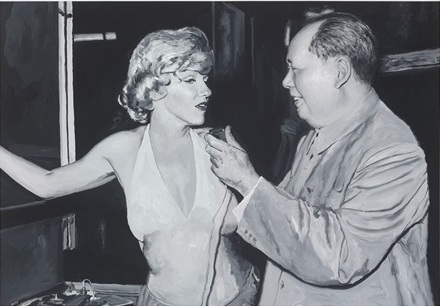

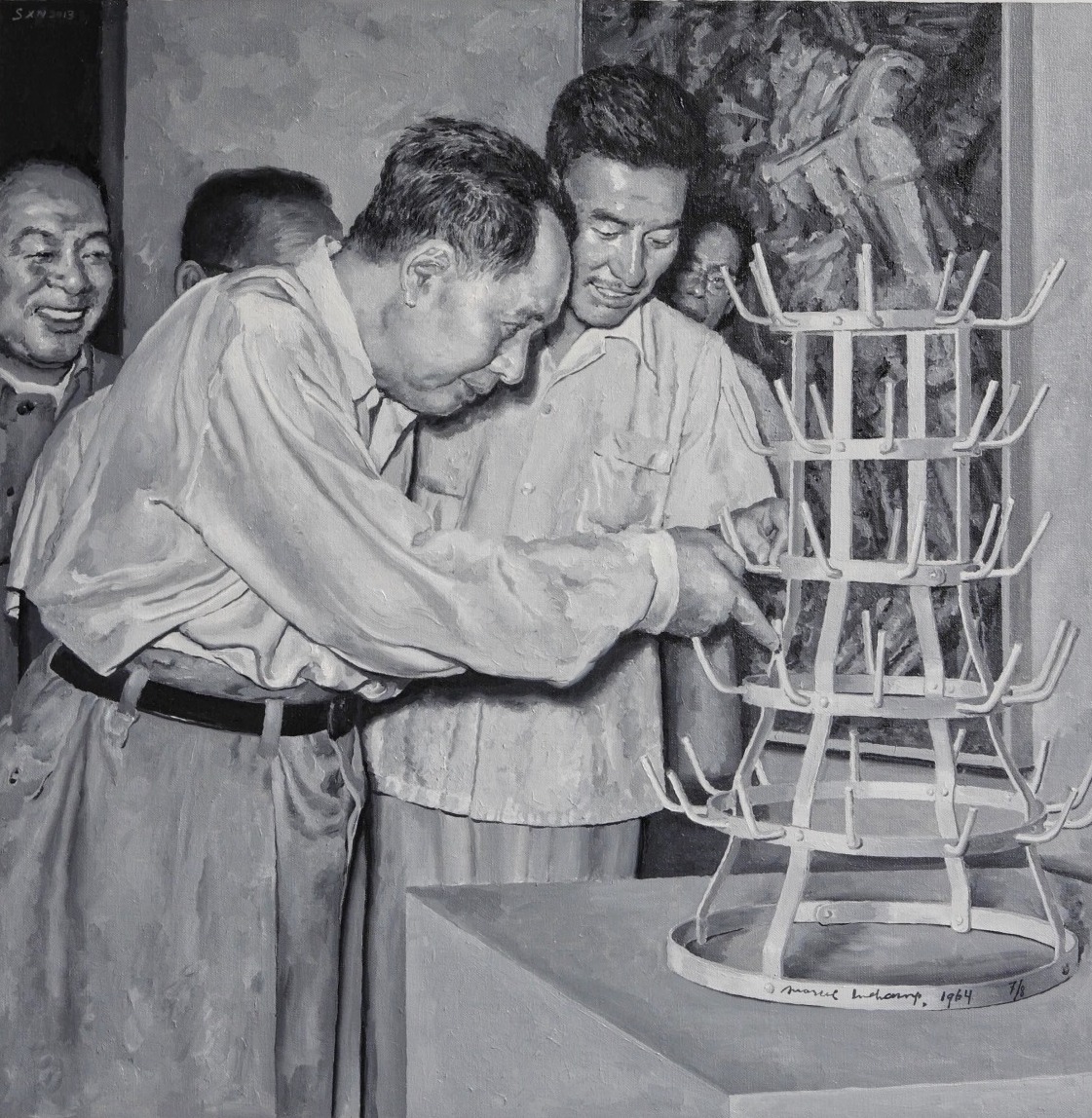
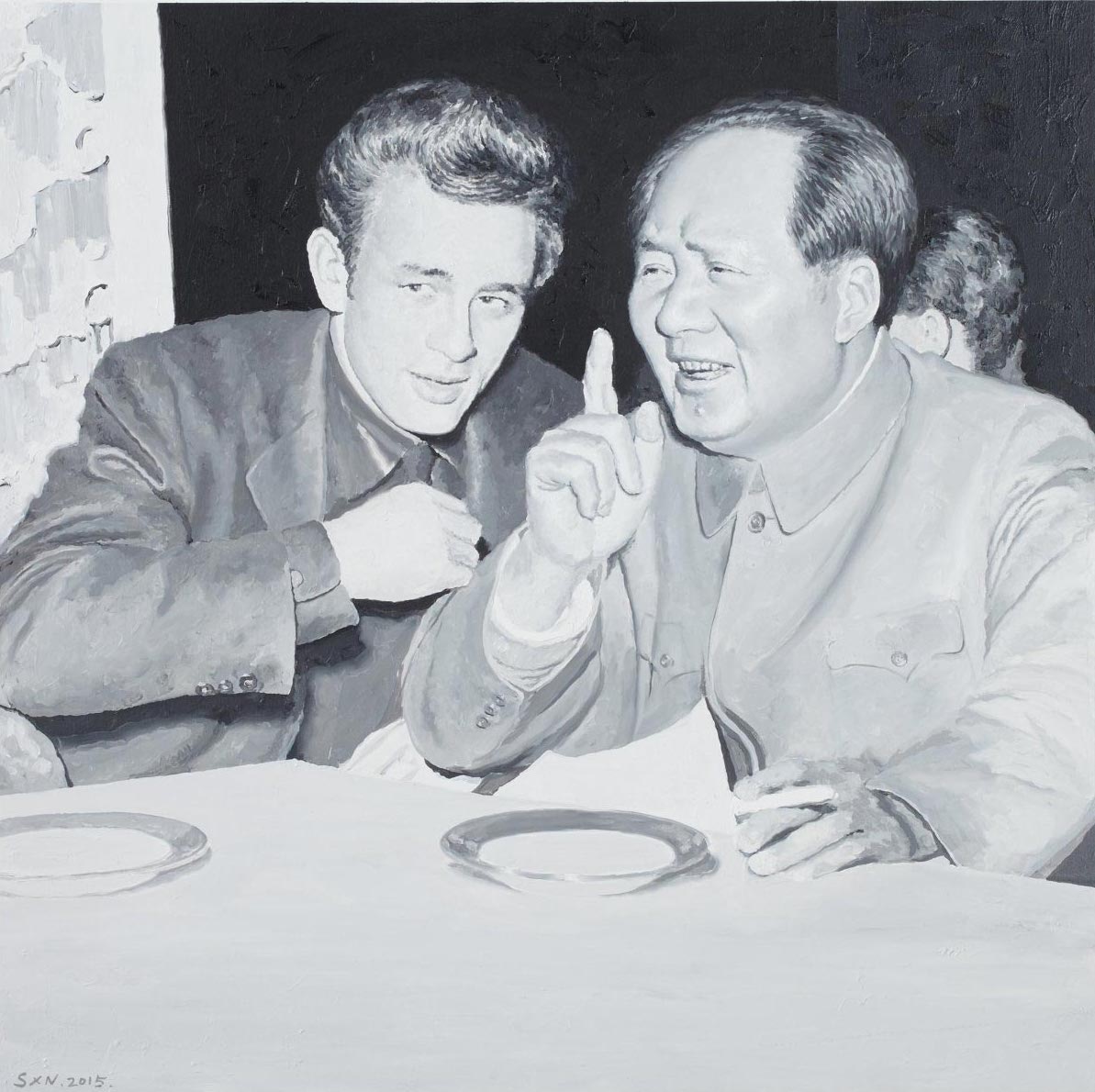
_______________
Bruce Nauman Violent Incident, 1986
‘Violent Incident begins with what is supposed to be a joke – but it’s a mean joke. I started with a scenario, a sequence of events which was this: Two people come to a table that’s set for dinner with plates, cocktails, flowers. The man holds the woman’s chair for her as she sits down. But as she sits down, he pulls the chair out from under and she falls on the floor. He turns around to pick up the chair, and as he bends over, she’s standing up, and she gooses him. He turns around and yells at her – calls her names. She grabs the cocktail glass and throws the drink in his face. He slaps her, she knees him in the groin and, as he’s doubling over, he grabs a knife from the table. They struggle and both of them end up on the floor.
‘In the installation, the short sequence described above is repeated in three other versions: the couple exchange roles; it is played by two men; it is played by two women. Each version has been edited with slow-motion, colour change, and the addition of footage filmed during the rehearsals in which the action was deconstructed by a man’s voice shouting out instructions. The four looped videotapes are played on twelve monitors stacked up in four columns of three. This results in a wall of staggered action, sound and motion which intrudes aggressively into the space around it: ‘The images are aggressive, the characters are physically aggressive, the language is abusive. The scripting, having the characters act out these roles and the repetition all build on that aggressive tension.’ The viewer is presented with a hypnotic repetition of pointlessly cruel and destructive violence which is both seductive and alienating.’
_______________
Adrian Piper Catalysis, 1970
‘It was Piper’s work that taught me to ask the questions that I want answered, rather than to answer questions that should never have been asked. Born into a mixed-race family in 1948 and privately educated from high school through university in New York City, Piper was also accustomed to existing in majority-white spaces from an early age. These spaces are ruled by specific codes of conduct, many unspoken and often unquestioned. In her early series of performances, Piper began to explore what existed beyond their limits.
‘She called these performances, staged during the early 1970s, Catalysis, after her ability to “catalyse” or affect audiences. In one, she caught the D Train during the New York rush hour in a coat carefully marinated in eggs, vinegar, fish oil and milk. In another, she went shopping at Macy’s dripping in white paint and wearing a sign that read “WET PAINT”. She filled her purse with ketchup and fished out a comb, a mirror or loose change while on the bus and in public restrooms. She shoved towels into her mouth and stared back at people on the street, her face bulging with excess.
‘Her interventions were out of the ordinary, but they also proved how lenient a working definition of the ordinary could be. When she asked someone on a subway platform for the time, they gave it to her. “You know you are in control, that you are a force acting on things, and it distorts your perception,” she said in an interview with Lucy Lippard in 1972. “The question is whether there is anything left to external devices or chance. How are people when you’re not there?”

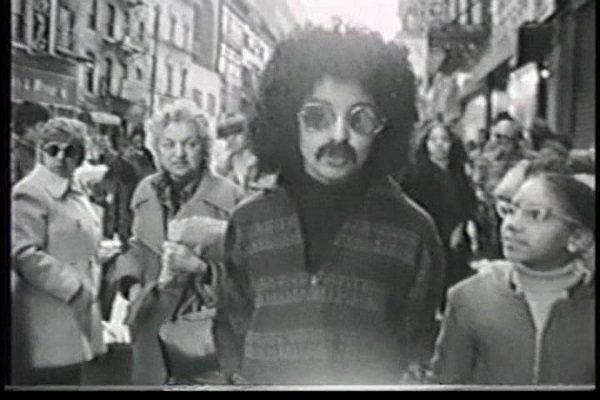
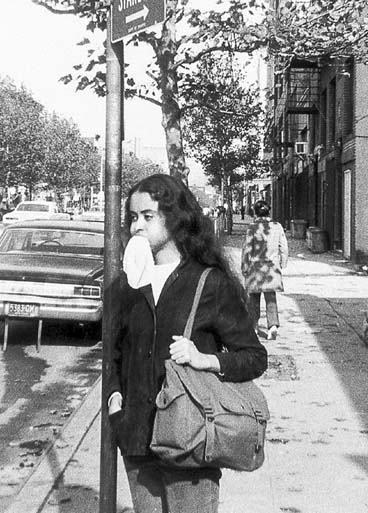
_______________
John Miller Dress Rehearsal for the Revolution, 2019
‘For Dress Rehearsal for the Revolution, Miller configured a mannequin school of rock, deadpan and frozen in a state of detached contemplation. Read together, the ensemble prompts questions about youth culture as a projection screen for hopes of societal renewal. How might one reconcile this optimism with the realities of nine-to-five conformism and corporate ownership of labor?’

_______________
‘A Palestinian arts centre located in the west of Gaza City was destroyed on Thursday by a series of Israeli air strikes. The Israeli military said that they had targeted the Al-Meshal Cultural Center, as it was being used as headquarters by Hamas. The Palestinian-Islamist organization, in control of the Gaza Strip, later claimed that the Israeli Defense Forces had taken out the wrong building, and that their headquarters was in fact positioned across the road. An Israeli spokesperson initially said that the targeted building housed Hamas’s interior security forces, who were using it for military purposes and as an office for ‘active unit members’. The IDF said that they had carried out the strike in retaliation for rockets fired by Hamas at Israel.
‘Palestinians disputed the claim, with one local telling Israeli newspaper Haaretz that ‘the attacked building is an art and culture centre which has no political or security use […] There is no reason to target this building other than harming a Palestinian cultural symbol.’ The building is said to have hosted a library and Egyptian community centre, as well as an arts theatre. Theatre director Idrees Taleb told Middle East Eye that the building had no relation to any political party: it had ‘nothing to do with Palestinian political factions.’ A young artist, Alaa Qudaih, lamented the reduction of the arts centre to ruins, telling the news organization: ‘I used to visit the al-Meshal centre regularly because I am interested in art and theatre, especially since there are no real cinemas in Gaza.’’



_______________
Ruth Ewan Another Time, 2016–2019
‘Ruth Ewan’s project Another Time is designed as an ‘anarchist laboratory of the revolution-to-come’, freeing plants from the pages of design magazines and Instagram timelines to look at them as agents of revolutionary activity. Another Time draws from Swedish taxonomist Carl Linnaeus’ hypothesis for a garden plan formed of flowers that open and close at different times of the day. In her ‘floral clock’, Ewan invited the local community in Cambridge to plant over 5 million seeds in a field next to Cambridge University’s Gravel Hill Farm workers’ cottages. Instead of replicating the numbers on a clock, the seeds were spread across the field, proposing a new reading of time that is ‘stretchy, unpredictable, open, pulsating’.’


_______________
Shada Safadi Promises, 2012
‘Light cast on the stilted forms creates eerie shadows that the viewer alters and becomes part of as they walk through the panes. Safadi, born in the occupied Syrian Golan Heights, uses the forms to represent those lost in the Syrian uprising. Her piece makes the viewers one of them. She writes in the catalog, “You still exist and we were meant to stay alive, but our freedom is still incomplete; you are dead and we are the dead too.”’
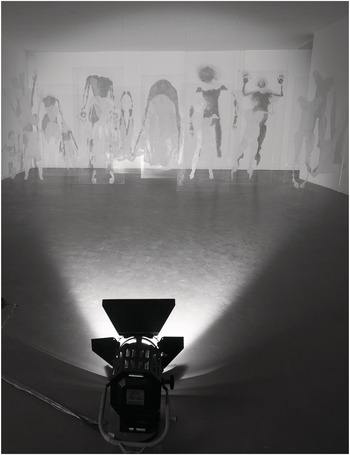
_______________
Sanja Iveković Personal Cuts, 1982
‘In Personal Cuts, which aired on prime-time Yugoslavian national television in 1982, Iveković counters the official history of socialism. Newsreel images—mass rallies, monuments, and a public address by Yugoslav President Tito—alternate with footage of the artist cutting holes into a sheer black stocking pulled over her face, like the DIY version of a militant’s balaclava. For Iveković, the repeated act of cutting into fabric is emblematic of film- and video-editing strategies such as montage. Revealing the insidiousness of national propaganda and questioning the unified stories told through official channels, she frames historical events as inextricably linked to human ones, ending the video with her face fully uncovered.’
_______________
Vito Acconci Following Piece, 1969
‘Half a century ago, the Architectural League invited Vito Acconci to participate in an “exhibition” on the streets of NYC. What he came up with was Following Piece (1969): “Each day I pick out, at random, a person walking in the street. I follow a different person everyday; I keep following until that person enters a private place (home, office, etc.) where I can’t get in.” Over the course of the month, Acconci followed 23 individuals for durations ranging from a few minutes to eight hours. Beyond a series of staged photographs taken after the fact, his documentation consists only of affectless descriptors, a list of incidents such as “11:10AM … Man in brown jacket; he walks south on Bleecker.” Today, Following Piece can be readily understood as a kind of algorithm, one that is also performed by the countless apps, cameras, and sensors that keep tabs on us as we move around the city every day. In fact, Acconci described himself as an automaton, writing in his notes that once he determined the formula for the piece, “I don’t have to control myself … I am almost not an ‘I’ anymore; I put myself in the service of this scheme.”’
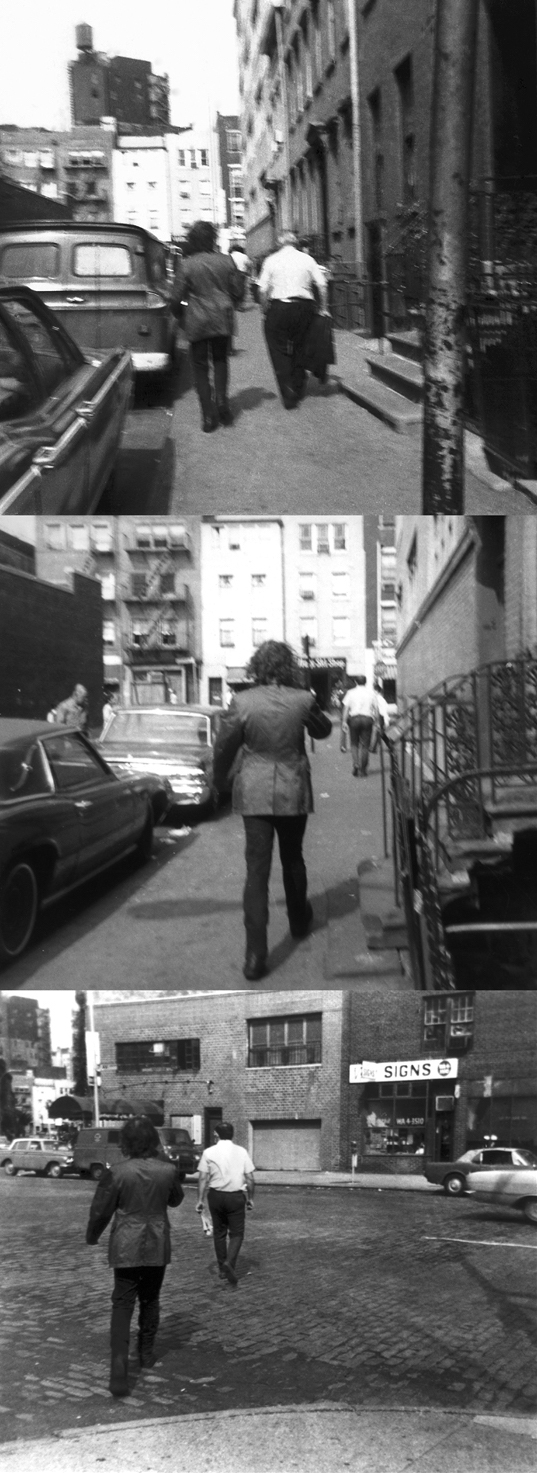
_____________
Annette Lemieux Black Mass, 1991
‘Annette Lemieux’s Black Mass shows a demonstration that looks like an early Soviet demonstration, as we know them from films by Eisenstein and Vertov. However, instead of revolutionary propaganda posters, the demonstrators carry copies of Malevich’s Black Square. This produces a certain ironic effect. There is, indeed, an analogy between the October Revolution and Malevich’s Black Square: both were internationalist and universalist. Even if the masses have never demonstrated for avant-garde art, the image of Malevich is aesthetically compatible with the left-wing politics of his time. But this image is incompatible with any return to nationalism and “traditional cultural values.” Indeed, it proclaims the nullification of these values.’

_____________
Shirin Neshat Fervor, 2000
‘In this piece, Shirin Neshat depicts two stories, one of a man, and another a woman, both in the same place, at the same time on independent screens. Throughout the narrative there is an infuriating conflict between the focal characters, as they both notice each other’s presence even without being able to see one another. This tension builds until the female character leaves, creating a feeling of helplessness with the audience. This division between the projection screens helped to depict the separation and distance of love within the culture, and separation from the women in this society, a detachment possibly felt by the artist after the Islamic revolution in Iran.’
______________
Wayne Hodge Negerkuss, 2011
‘Wayne Hodge references the German confection Negerkuss, or “Negro’s Kiss,” a chocolate-and-marshmallow sweet. In the original live performance in Berlin, Hodge featured a replica of the bust of Cleopatra (ca. 35 BC), housed in Germany’s national museum in Berlin. Donning this mask of a “black savage”—a popular mask worn in some German carnival celebrations—Hodge methodically and systematically blackens the bust. Using oil stick paint, he gives the bust a “Negro’s kiss” until it is completely covered in pigment.’
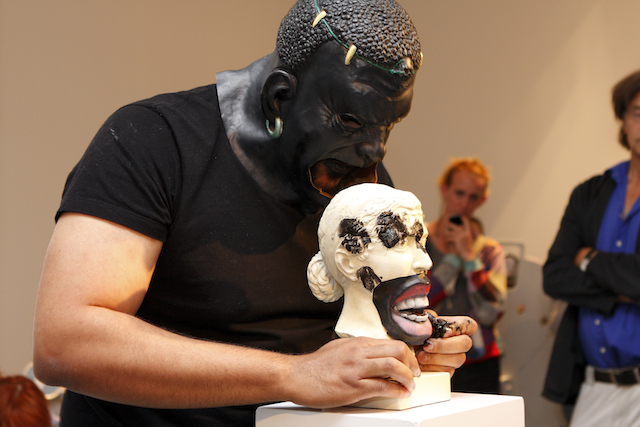

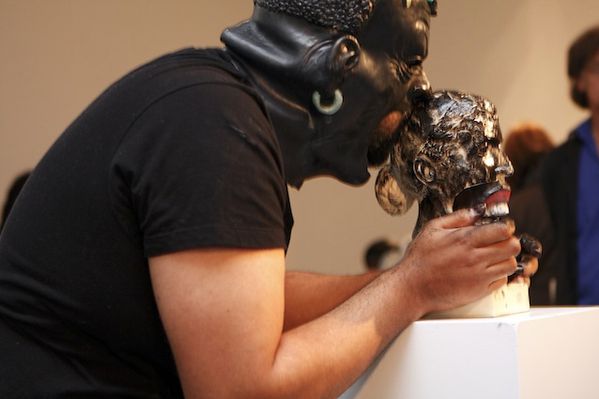

*
p.s. Hey. ** Dominik, Hi!!! Yeah, she was kind of an ‘It’ girl at a certain point there. I guess she prioritised being ‘It’ by virtue of the company she kept over being ‘It’ due to her acting. Ha ha, I have never begun to understand what being ‘one with your body’ would feel like. Or what would cause someone to say something like that. I mean, technically, we’re all one with our bodies every second. It’s called being alive. As someone who has eaten fried cheese for years straight sans boredom, I would say your love of yesterday is highly achievable. Love deciding yesterday while leaning out my window at dusk smoking a cigarette and watching these four bats who live in the roof of our building doing their daily routine of flying soundlessly at high speed in veering circles around our courtyard that bats are the most amazing creatures in the world, G. ** _Black_Acrylic, I thought so too. Even ‘Godfather 3’? Or I mean does it finally hold up after all these years? Thank you about the funding. It’s going to take some magic. ** David Ehrenstein, Hi. Yeah, ‘I Am Love’ was pretty good. Oh, yes, I forgot that about Berry Berenson’s end. So weird. ** Steve Erickson, Hi. Just the idea that ancap/libertarians have anything remotely to do with anarchism is a sad but unsurprisingly uninformed leap. Anarchism is weird because, one on the one hand, its principles are very simple, but, on the other hand, every anarchist’s anarchism is by virtue of the belief system’s definition entirely unique, so, yeah, it’s virtually impossible to represent accurately, which is, of course, a victory. Everyone, Steve has written two no doubt very interesting reviews. Here he is: ‘Slant Magazine published two of my music reviews today, on Superorganism’s WORLD WIDE POP and black midi’s HELLFIRE.’ ** Misanthrope, Oh, yeah? I don’t like anything about his playing or him, and, at the same time, I don’t really give a shit, so his win was a shrug for me. I hope that guy’s scratchy throat didn’t emit particles that wound up sneaking into your nostrils or mouth or eyes. ** Damien Ark, Hi, Damien. I’m so sorry to hear that. I don’t think I’ve read Eris’s work. It’s sadly late, but I’ll go discover it. That’s terrible news. Hugs to you, man. ** Okay. Revolutioinize, please. See you tomorrow.




 Now available in North America
Now available in North America 
In the UK right now is the Conservative leadership contest, and that’s gonna fill the news cycle here until at least December. I said to my mum yesterday that I’m just gonna ignore politics for a decade. We’ll see how that one goes.
Yesterday we went over to the local hospital where I was prescribed a power wheelchair for using when I move into the new flat, later in the year. It’s a motorised thing controlled by a joystick on the handle, and I did get used to using it pretty quickly. Major lifestyle changes up ahead so look out for it.
My mini Godfather binge is not including part 3. There is this new doc series about the making of the first one that I may check out some time soon.
Hi!!
Yes, it seems like it. Actually, I have the impression that quite a lot of people operated that way in those circles at the time – being “It” by virtue of the company they kept rather than anything they did.
Technically, yes. But still, I kind of think about that in the terms of “it’s good that my body’s alive ‘cause otherwise I wouldn’t have anywhere to live.” And it’s strange to imagine that there’re people who don’t feel like they inhabit their bodies but that they ARE their bodies.
Ah, another fried cheese fan! It’s my number one comfort food – safe and desirable under almost any circumstances, haha.
I adore bats as well. I absolutely agree with your love. Love making everyone say every single thought that crosses their mind out loud for a whole day, Od.
The works here have a real ‘bite,” and that type of activity is really missing now – at least on a mainstream political level. Weirdly enough, the Right has seemed to take on the outrage of life and had/has the ability to go with it. There are traces now, such as Pussy Riot, but mainly from the Left; it is a shrug looking downward. But maybe that’s an American thing right now? The Mao paintings by Shi Xinning have a real presence. Fantastic work; in fact, the entire blog today is really something. Thanks for the work today!
TheEmbodiment of Tevolution: The Living YTheater
https://www.gofundme.com/f/fundraising-for-our-friend-david-ehrenstein?member=15151553&utm_campaign=p_cp+share-sheet&utm_medium=copy_link_all&utm_source=customerps://mail.yahoo.
(My GoFundMePage)
Thank you, Dennis, for reminding me of Leon Golub’s name! When I was a kid, classical painting started to click for me after a visit to the Art Institute of Chicago where I saw Golub’s “Interrogation II” (the red one with four cops torturing the shrouded nude) and Manet’s “The Mocking of Christ” in succession.
As for revolution; I used to have a sort of resentful acceptance for Trotsky politically and Breton artistically until I found out the two were friends and correspondents, now I’m more enthusiastically into both.
Also the post made me think of this: https://www.youtube.com/watch?v=iAbGOP7YqlM
“Dress Rehearsal for a Revolution” is a weird one in the context of the Millennials no longer being the youth generation. Are kids still starting bands and thinking it’s revolutionary? I hope so.
Sorry I’m spotty with the comments and conversation! I just got back from the Keys. I feel like every not-big-enough town in America has a co-ed gay bar that has karaoke where people sing sad alt rock songs instead of fucking each other. Not that I didn’t have a good time. Hope Paris is just as riveting.
Despite the flaws of its title and concept, I thought THE ANARCHISTS was worth watching, but its subjects’ only problem with hierarchy and authority seems to be the fact they’re not at the top. Everyone uses “freedom” as a meaningless buzzword. The only person in the doc who comes off as likable or smart is a woman who grew cannabis to treat her chronic pain, was arrested for it and faced a possible 25 years in jail.
In Gay City News, I wrote about the New York Asian Film Festival, which starts Friday: https://gaycitynews.com/lgbtq-new-york-asian-film-festival-movies/. If PERHAPS LOVE and ANGRY SON make their way around the world, I’d recommend them. I hope to see a few more films from the festival.